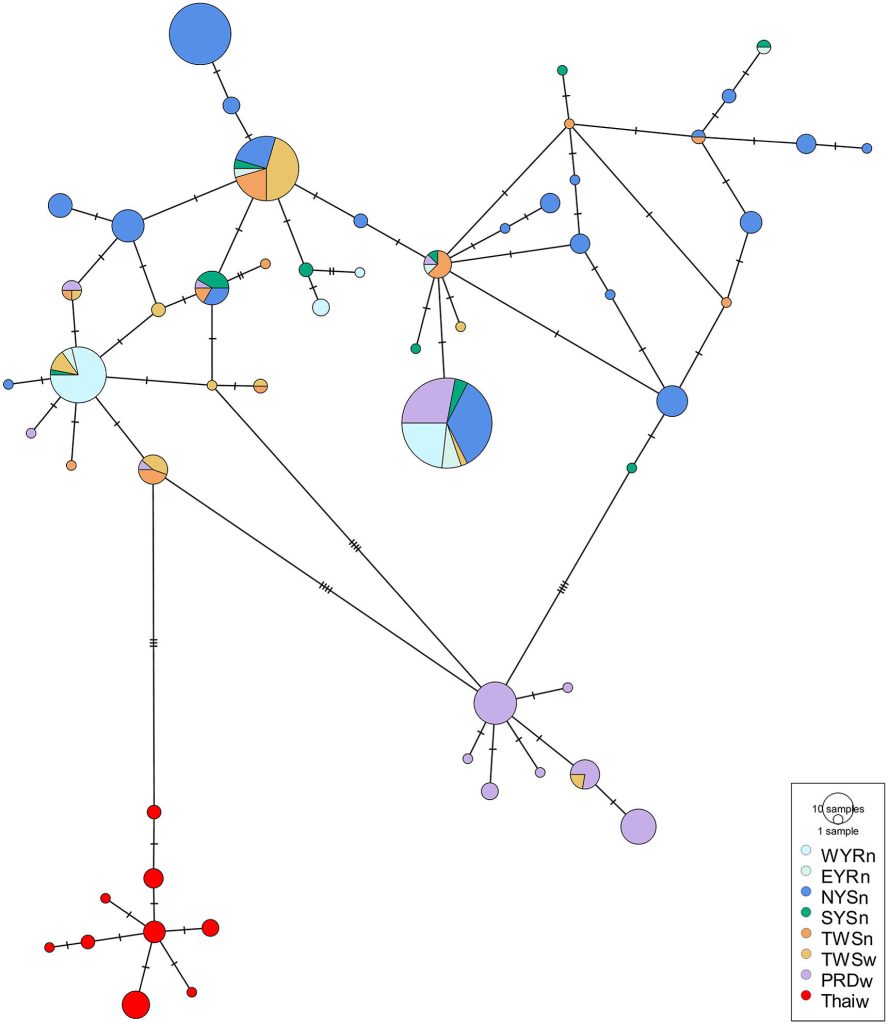The minimum spanning network of the finless porpoise. Credit: Water Biology and Security (2022). DOI: 10.1016/j.watbs.2022.100094
The finless porpoise, a relative of dolphins and whales, is native to the Indian and Pacific oceans, as well as the freshwater habitats of the Yangtze River basin in China. The Yangtze river’s finless porpoise is one of the very few porpoises that live in fresh water. Its small size and cute ‘smile’ make it much loved in the country and beyond.
Beyond its adorable appearance, however, lies a dire truth—the finless porpoise is critically endangered, with conservation attention and action remaining inadequate. This may be in part attributed to the disproportionate research efforts across the Indo-Pacific region. The spatial genetic structure of finless porpoise is poorly understood, which further led to poor phylogeographic knowledge and ambiguous taxonomic classification of many Indo-Pacific cetacean species.
To address this critical knowledge gap, a team of researchers from China and Thailand came together to investigate the spatial genetic pattern of the finless porpoise from the East China Sea to Gulf of Thailand, using both mitochondrial and autosomal DNA markers.
“We also included narrow and wide-ridged finless porpoises from the Taiwan Strait, which are usually taken as the inter-species divergence within the genus, as a reference to better illustrate the genetic stratification of the finless porpoise across the region,” says first author of the study, Dr. Wenzhi Lin from the Institute of Deep-sea Science and Engineering of Chinese Academy of Science.
“We found a minimum of four genetic populations within the study areas, corresponding to the narrow-ridged finless porpoise from the Taiwan Strait, and the three wide-ridged finless porpoise populations from the Taiwan Strait, together with the Pearl River Delta region and the Gulf of Thailand.”
The minimum spanning network of the mtDNA control region found shared haplotypes among finless porpoises in Chinese waters, but those from the Gulf of Thailand formed a unique matriline lineage. The genetic differentiation, or divergence, within the South China Sea also appears to be higher than that of most finless porpoise populations examined to date.
“The Mantel test detected a strong correlation between the geographic and genetic matrices within the South China Sea, indicating that the divergence associated with isolation-by-distance has been accumulating in recent history,” adds Lin.
The findings from the joint study are published in Water Biology and Security.
The team also notes that the relatively low level of divergence, especially those between neighboring locations, suggests the presence of ongoing, albeit low, gene flow. If proven so, the evolutionary significant unit should be clearly defined before conservation attention is applied to correctly direct efforts to populations with distinctive features.
“Inter-population connectivity should also be carefully evaluated, and conservation action may be required to maintain necessary gene flow,” concludes Prof Songhai Li, senior scientist of the study.
More information: Wenzhi Lin et al, Novel insights into the spatial genetic patterns of the finless porpoise from East to Southeast Asia, Water Biology and Security (2022). DOI: 10.1016/j.watbs.2022.100094
Provided by KeAi Communications
Citation: Joint effort discloses deep divergence of a mysterious porpoise (2023, January 17) retrieved 2 February 2023 from https://phys.org/news/2023-01-joint-effort-discloses-deep-divergence.html
This document is subject to copyright. Apart from any fair dealing for the purpose of private study or research, no part may be reproduced without the written permission. The content is provided for information purposes only.

